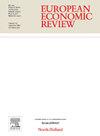房价,内生生产率,以及政府支出冲击的影响
IF 2.8
2区 经济学
Q1 ECONOMICS
引用次数: 0
摘要
我们提出了总体和区域证据,表明美国房价持续上涨,以应对财政支出的积极冲击。与此形成鲜明对比的是,在传统的动态一般均衡模型中,房价下跌,对住房影子价值产生短期影响的冲击不可避免地会在家庭消费边际效用和房价之间产生负运动(见Barsky et al., 2007)。作为对政府支出增加的回应,同时增加现值税负所产生的负财富效应增加了消费的边际效用。即使克服了消费挤出难题,也不足以解决这一缺陷。为了解决这个问题,我们扩展了一个标准模型,该模型将借贷关系与另一种(但可能是互补的)传播渠道相结合,利用财政支出的积极冲击带来的全要素生产率的增长,从而对比高税收带来的负财富效应。这类模型成功地产生了房价的持续扩张,尽管与数据匹配所需的传播比文献中通常发现的更强——在某些情况下明显如此。房价和生产率之间的积极相互作用在总体和区域数据中都得到了支持。本文章由计算机程序翻译,如有差异,请以英文原文为准。
House prices, endogenous productivity, and the effects of government spending shocks
We present aggregate and regional evidence showing that U.S. house prices increase persistently in response to positive shocks to fiscal spending. In sharp contrast to this, house prices decline in conventional dynamic general equilibrium models, where shocks that have short-lived effects on the shadow value of housing inevitably generate negative comovement between households’ marginal utility of consumption and house prices (see Barsky et al., 2007). In response to an increase in government spending, the negative wealth effect exerted by the simultaneous increase in the present-value tax burden increases the marginal utility of consumption. Even overcoming the consumption crowding-out puzzle is not sufficient to resolve this shortcoming. To tackle this problem, we extend an otherwise standard model embedding a lender-borrower relationship with alternative – yet, potentially complementary – propagation channels that leverage the expansion in total factor productivity stemming from a positive shock to fiscal spending, so as to contrast the negative wealth effect of higher taxes. This class of models succeeds in generating a persistent expansion in house prices, although the propagation required to match the data is stronger – in some cases significantly so – than what is typically found in the literature. The positive interplay between house prices and productivity finds support in both aggregate and regional data.
求助全文
通过发布文献求助,成功后即可免费获取论文全文。
去求助
来源期刊

European Economic Review
ECONOMICS-
CiteScore
4.70
自引率
3.60%
发文量
170
期刊介绍:
The European Economic Review (EER) started publishing in 1969 as the first research journal specifically aiming to contribute to the development and application of economics as a science in Europe. As a broad-based professional and international journal, the EER welcomes submissions of applied and theoretical research papers in all fields of economics. The aim of the EER is to contribute to the development of the science of economics and its applications, as well as to improve communication between academic researchers, teachers and policy makers across the European continent and beyond.
 求助内容:
求助内容: 应助结果提醒方式:
应助结果提醒方式:


